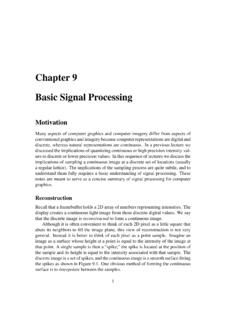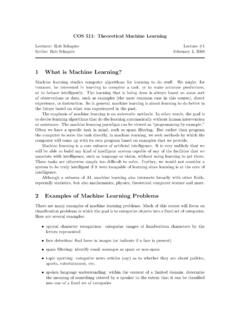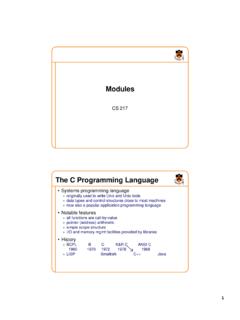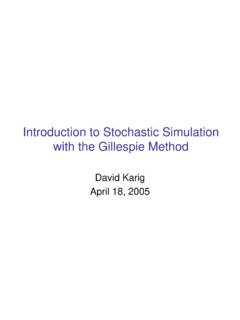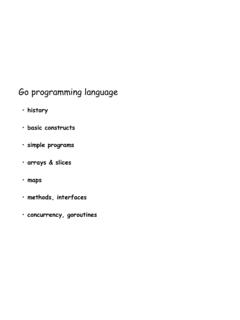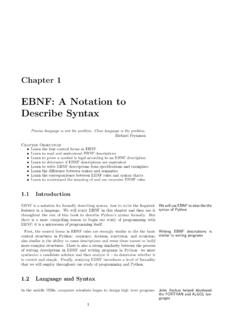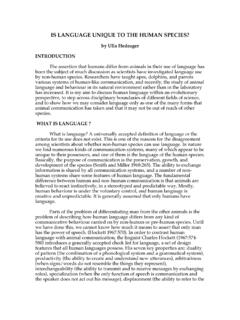Transcription of The cognitive revolution: a historical perspective
1 The cognitive revolution :a historical perspectiveGeorge A. MillerDepartment of Psychology, Princeton University, 1-S-5 Green Hall, Princeton, NJ 08544, USAC ognitive science is a child of the 1950s, the product ofa time when psychology, anthropology and linguisticswere redefining themselves and computer science andneuroscience as disciplines were coming into could not participate in the cognitiverevolution until it had freed itself from behaviorism,thus restoring cognition to scientific respectability. Bythen, it was becoming clear in several disciplines thatthe solution to some of their problems depended cru-cially on solving problems traditionally allocated toother disciplines. Collaboration was called for: this is apersonal account of how it came can make history. Only agreat man can write Wilde s aphorism is appropriate. At the time, thesuggestion that we were making history would have beenpresumptuous. But anybody can make history; writinghistory is another matter.
2 I know something of thescholarship required and nothing approaching it hasgone into the story I will tell here. But I offer this personalaccount in the hope that it might interest and help the realhistorians of the time it was happening I did not realize that I was,in fact, a revolutionary, and two different stories becameintertwined in my life. They unfolded concurrently but Iwill tell the psychological story cognitive revolution in psychologyThe cognitive revolution in psychology was a counter- revolution . The first revolution occurred much earlierwhen a group of experimental psychologists, influenced byPavlov and other physiologists, proposed to redefinepsychology as the science of behavior. They argued thatmental events are not publicly observable. The onlyobjective evidence available is, and must be, changing the subject to the study of behavior,psychology could become an objective science based onscientific laws of behavioral revolution transformed experimentalpsychology in the US.
3 Perception became discrimination,memory became learning, language became verbal beha-vior, intelligence became what intelligence time I went to graduate school at Harvard in the early1940s the transformation was complete. I was educated tostudy behavior and I learned to translate my ideas into thenew jargon of behaviorism. As I was most interested inspeech and hearing, the translation sometimes becametricky. But one s reputation as a scientist could depend onhow well the trick was 1951, I publishedLanguage and Communication[1],a book that grew out of four years of teaching a course atHarvard entitled The Psychology of Language . In thepreface, I wrote: The bias is behavioristic not fanaticallybehavioristic, but certainly tainted by a preference. Theredoes not seem to be a more scientific kind of bias, or, if thereis, it turns out to be behaviorism after all. As I read thatbook today it is eclectic, not behavioristic. A few yearslater Skinner publishedVerbal Behavior[2], a trulybehavioral treatment of language and communication.
4 BySkinner s standards, my book had little or nothing to dowith 1951, I apparently still hoped to gain scientificrespectability by swearing allegiance to behaviorism. Fiveyears later, inspired by such colleagues as Noam Chomskyand Jerry Bruner, I had stopped pretending to be abehaviorist. So I date the cognitive revolution in psychol-ogy to those years in the early of information theoryDuring those years I personally became frustrated in myattempts to apply Claude Shannon s theory of informationto psychology. After some initial success I was unable toextend it beyond Shannon s own analysis of lettersequences in written texts. The Markov processes onwhich Shannon s analysis of language was based had thevirtue of being compatible with the stimulus responseanalysis favored by behaviorists. But informationmeasurement is based on probabilities and increasinglythe probabilities seemed more interesting that theirlogarithmic values, and neither the probabilities northeir logarithms shed much light on the psychologicalprocesses that were responsible for was therefore ready for chomsky s alternative toMarkov processes.
5 Once I understood that Shannon sMarkov processes could not converge on natural language,I began to accept syntactic theory as a better account of thecognitive processes responsible for the structural aspectsof human language. The grammatical rules that governphrases and sentences are not behavior. They areCorresponding author:George A. Miller in cognitive March 2003141 $ - see front matterq2003 Elsevier Science Ltd. All rights reserved. (03)00029-9mentalistic hypotheses about the cognitive processesresponsible for the verbal behaviors we end of behaviorismBehaviorism was an exciting adventure for experimentalpsychology but by the mid-1950s it had become apparentthat it could not succeed. As chomsky remarked, definingpsychology as the science of behavior was like definingphysics as the science of meter reading. If scientificpsychology were to succeed, mentalistic concepts wouldhave to integrate and explain the behavioral data.
6 We werestill reluctant to use such terms as mentalism to describewhat was needed, so we talked about cognition we called it, the cognitive counter-revolutionin psychology brought the mind back into experimentalpsychology. I think it is important to remember that themind had never disappeared from social or clinicalpsychology. It was only experimentalists in the US whoreally believed that behaviorism would work. In myown case, when I became dissatisfied at Harvard Skinner s strict behaviorism and Stevens psychophysics, I turned to Jerry Bruner s social psychol-ogy, and in 1960 that led to the creation at Harvard of theCenter for cognitive Studies. Bruner s group at BowStreet had been calling themselves the Cognition Project for some time, so we simply changed it from a project to acenter. Bruner obtained a grant from the CarnegieCorporation of New York and Dean Bundy gave us spaceto house the enterprise.
7 We assembled a group of brightyoung graduates and a few senior scholars who shared ourinterests. Peter Wason, Nelson Goodman and NoamChomsky had the most influence on my thinking at flourished primarily in the US and thiscognitive revolution in psychology re-opened communi-cation with some distinguished psychologists abroad. InCambridge, UK, Sir Frederic Bartlett s work on memoryand thinking had remained unaffected by behaviorism. InGeneva, Jean Piaget s insights into the minds of childrenhad inspired a small army of followers. And in Moscow, Luria was one of the first to see the brain and mind asa whole. None of these three spent time at the Center butwe knew their work well. Whenever we doubted ourselveswe thought of such people and took courage from m happy to say the Harvard Center for CognitiveStudies was a success. The bright young graduates grewup to become important psychologists unafraid of was how I experienced the cognitive revolution cognitive revolution and cognitive scienceWhile experimental psychologists were rethinking thedefinition of psychology, other important developmentswere occurring elsewhere.
8 Norbert Wiener s cyberneticswas gaining popularity, Marvin Minsky and JohnMcCarthy were inventing artificial intelligence, andAlan Newell and Herb Simon were using computers tosimulate cognitive processes. Finally, chomsky wassingle-handedly redefining the historical Addendum to Newell and Simon sHuman Problem Solving[3]they say: 1956 could be takenas the critical year for the development of informationprocessing psychology (p. 878). This is not difficult tojustify. 1956 was the year that McCarthy, Minsky,Shannon and Nat Rochester held a conference on artificialintelligence at Dartmouth that was attended by nearlyeveryone working in the field at that time. In 1956 Shannon and McCarthy editedAutomata Studies[4],and Minsky circulated a technical report that, after manyrevisions, and 5 years later, became his influential article, Steps toward artificial intelligence [5].
9 It was also in 1956 that Jerry Bruner, Jackie Goodenoughand George Austin publishedA Study of Thinking[6],which took seriously the notion of cognitive strategies. In1956 signal-detection theory was applied to perception byTanner, Swets, Birdsall and others at Michigan. Ipublished an article entitled The magical number seven,plus or minus two [7]describing some limits on our humancapacity to process information. In 1956 Ward Goodenoughand Floyd Lounsbury published several articles oncomponential analysis that became models for cognitiveanthropology, and Carroll edited a collection ofpapers by Benjamin Lee Whorf on the effects of languageon short, 1956 was a good year for those interested intheories of the mind, but it was only slightly better thanthe years just preceding and following. Many were ridingthe waves that began during World War II: those of servotheory, information theory, signal-detection theory, com-puter theory and computers of conceptionNewell and Simon were right to put a finger on 1956, whichwas not only crucial in their own development but for all ofus.
10 Indeed, I can narrow it down even further. I date themoment of conception of cognitive science as 11 September,1956, the second day of a symposium organized by the Special Interest Group in Information Theory at theMassachusetts Institute of Technology[8]. At the time, ofcourse, no one realized that something special hadhappened so no one thought that it needed a name; thatcame much chairman of the organizing committee was PeterElias, who had only recently arrived at MIT from a JuniorFellowship at Harvard. The first day, 10 September, wasdevoted to coding theory, but it is the second day of thesymposium that I take to be the moment of conception forcognitive science. The morning began with a paper byNewell and Simon on their logic machine . The secondpaper was from IBM: Nat Rochester and collaborators hadused the largest computer then available (an IBM 704 witha 2048-word core memory) to test Donald Hebb s neuro-psychological theory of cell assemblies.
